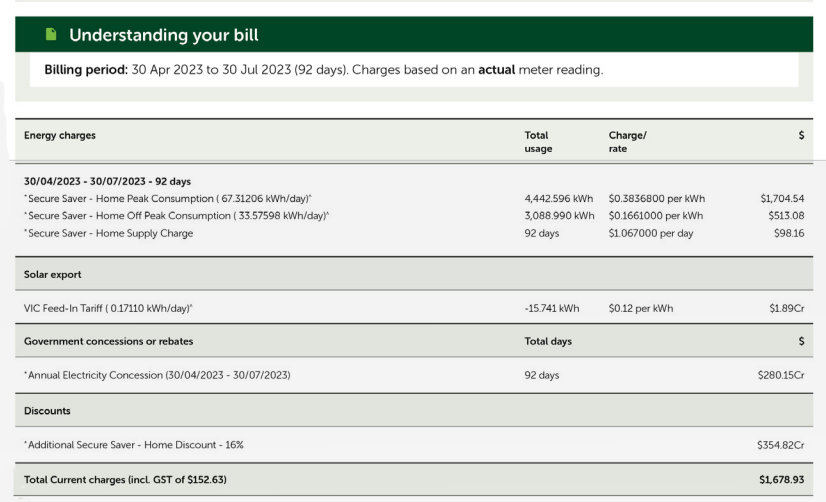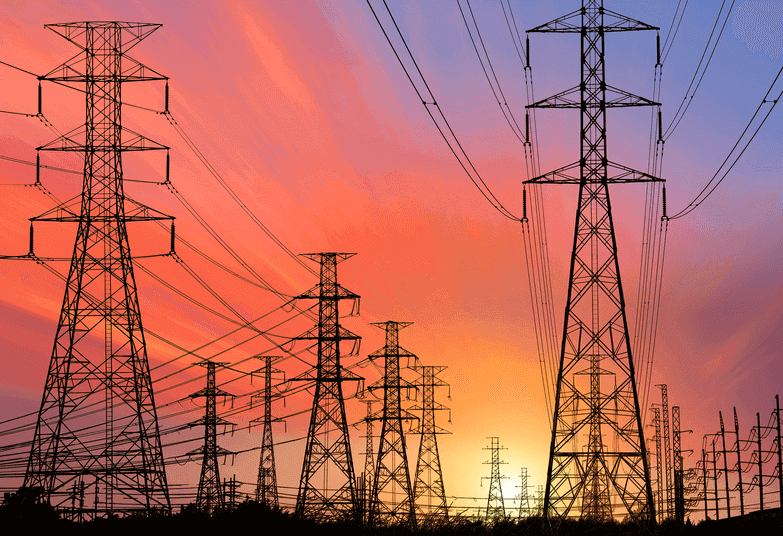KEY POINTS
- An electricity supply charge is what households pay to be connected to the electricity grid.
- It is not related to how much electricity you use, and will appear on your electricity bill without your household using any electricity.
- The electricity supply charge pays for maintenance of electricity poles and wires as well as general upkeep by the energy distributor.
In this article, Canstar Blue breaks down what an electricity supply charge is and how it impacts your energy bill.
Finding the best energy plan means understanding your typical energy usage, but it also means picking an energy provider with a competitive electricity supply charge. While you might try to cut back on energy use to save on your electricity costs, electricity supply charges are unavoidable regardless of power usage. Finding a cheap electricity supply charge is one of the things to consider when searching for a good energy deal as it will make a difference to your overall energy costs.
On this page:
- How much are electricity supply charges per day in Australia?
- What is a supply charge for electricity?
- What is the cheapest daily supply charge for electricity?
- Where do I find the daily supply charge for electricity on my bill?
- Why is there more than one electricity supply charge on my bill?
- Why do I need to pay a supply charge for electricity?
- Why understanding electricity supply charges is important
- Who sets electricity supply charges?
- When do electricity supply charges change?
How much are electricity supply charges per day in Australia?
What do electricity supply charges look like, and what can you expect to pay per day? Canstar Blue has calculated the average electricity supply charge in cents per day (c/day) for single rate tariffs across each distribution network in New South Wales, Victoria, South East Queensland, South Australia, the Australian Capital Territory and Tasmania.
← Mobile/tablet users, scroll sideways to view full table →
| State | Distribution Network | Average Electricity Supply Charge (c/day) |
|---|---|---|
| NSW | Ausgrid | 95.9c |
| NSW | Endeavour Energy | 105.4c |
| NSW | Essential Energy | 179.6c |
| VIC | AusNet Services | 119.6c |
| VIC | Citipower | 104.7c |
| VIC | Jemena | 108.2c |
| VIC | Powercor | 118.7c |
| VIC | United Energy | 99.5c |
| QLD | Energex | 123.9c |
| SA | SA Power Networks | 116.7c |
| ACT | Evoenergy | 120.5c |
| TAS | TasNetworks | 119.0c |
| Source: www.canstarblue.com.au – 15/01/2025. Average electricity usage rates are based on non-solar only plans on Canstar’s database for each respective rate type (single rate and controlled load), available for annual usages based on the reference usage amounts for each distributor for controlled load plans: NSW, VIC, QLD, and SA per AER, VIC per Victorian Default Offer, ACT per ICRC, TAS per the median usage in the Office of the Tasmanian Regulator’s report, Typical Electricity Customers in Tasmania 2022. Controlled load supply charges based on plans that have a supply charge for controlled loads. In Queensland, the tariffs are more commonly referred to as tariff 11 (single rate), tariff 31 (controlled load 1), and tariff 33 (controlled load 2). In Tasmania, the tariffs are more commonly referred to as tariff 31 (single rate), tariff 61 (controlled load 1) and tarrif 41 (controlled load 2). |
What is a supply charge for electricity?
An electricity supply charge is what households are charged for being continuously connected to the energy network. This is a cost charged in cents daily, with energy retailers adding up each daily charge to give you on your next bill. Electricity supply costs typically range from about 90c per day to $1.90 per day depending on your energy retailer and where you live.
So long as you want to be connected to the electricity network and receive power to your home, you’ll need to pay an electricity supply charge. While ‘electricity supply charge’ is now the most common term used to describe this cost, you may previously have seen it referred to as:
- Fixed charge
- Daily supply charge
- Service charge (or service to property charge).
The supply charge is not related to your usage – instead this figure on your bill is a daily amount your energy provider charges your property for being connected to the electricity grid. Even if you don’t use any electricity in a billing period, this rate will still be deducted provided that your energy supply is connected.
If you’re looking to cut your overall power costs, you will need to pay close attention to your electricity usage charges. Unlike your supply charge, you can have a direct impact on how much you pay for your energy usage by being more energy efficient around the home.
What is the cheapest daily supply charge for electricity?
As most electricity plans in Australia include variable rates, both your electricity supply charge and usage charge can change frequently. Looking for a cheap electricity supply charge is always a good idea, as this is one element of your overall bill that you can’t lower simply by using less electricity – you’ll be hit with a daily electricity supply charge no matter what.
However, when comparing electricity plans, also consider usage rates, the tariff type, and other factors such as discounts or credits. All of these will determine what your overall energy costs will be each billing cycle, along with how and when you use electricity.
Where do I find the daily supply charge for electricity on my bill?
An electricity supply charge is shown as cents per day on your energy bill and as the total amount for the billing period.
In the example below, you can see that a Victorian customer pays $1.067000 per day for electricity supply (or ‘home supply charge’), which adds up to $98.16 over a 92-day billing period.
 Image: EnergyAustralia
Image: EnergyAustralia
Energy deals with cheap electricity rates
Here are some of the cheapest published deals from the retailers on our database that include a link to the retailer’s website for further details. These are products from referral partners†. These costs are based on the Ausgrid network in Sydney but prices may vary depending on your circumstances. This comparison assumes general energy usage of 3900kWh/year for a residential customer on a single rate tariff. Please use our comparison tool for a specific comparison in your area. Our database may not cover all deals in your area. As always, check all details of any plan directly with the retailer before making a purchase decision.
Here are some of the cheapest published deals from the retailers on our database that include a link to the retailer’s website for further details. These are products from referral partners†. These costs are based on the Citipower network in Melbourne but prices may vary depending on your circumstances. This comparison assumes general energy usage of 4000kWh/year for a residential customer on a single rate tariff. Please use our comparison tool for a specific comparison in your area. Our database may not cover all deals in your area. As always, check all details of any plan directly with the retailer before making a purchase decision.
Here are some of the cheapest published deals from the retailers on our database that include a link to the retailer’s website for further details. These are products from referral partners†. These costs are based on the Energex network in Brisbane but prices may vary depending on your circumstances. This comparison assumes general energy usage of 4600kWh/year for a residential customer on a single rate tariff. Please use our comparison tool for a specific comparison in your area. Our database may not cover all deals in your area. As always, check all details of any plan directly with the retailer before making a purchase decision.
Here are some of the cheapest published deals from the retailers on our database that include a link to the retailer’s website for further details. These are products from referral partners†. These costs are based on the SA Power network in Adelaide but prices may vary depending on your circumstances. This comparison assumes general energy usage of 4000kWh/year for a residential customer on a single rate tariff. Please use our comparison tool for a specific comparison in your area. Our database may not cover all deals in your area. As always, check all details of any plan directly with the retailer before making a purchase decision.
Why is there more than one electricity supply charge on my bill?
Some households with a controlled load tariff, in addition to their standard tariff, will be charged an extra daily supply charge. This is because a controlled load is a separately metered tariff for larger appliances like hot water systems and pool pumps, which could also demand a daily electricity supply charge. Whether you need to pay this extra electricity supply charge depends on which energy distribution network you happen to live on. These costs are usually small in comparison to standard electricity supply charges, often just three or four cents per day.
Why do I need to pay a supply charge for electricity?
The cost of energy distribution (i.e. maintaining the poles and wires) makes up a significant part of your overall power costs. Energy distributors in each state pass these costs onto the energy retailers, who then pass them onto their customers. You could think of electricity supply charges as the costs incurred by your retailer for supplying energy to your property, especially given that it’s the local distribution company that actually sends someone to read your energy meter (if you don’t have a smart meter) every few months.
Why understanding electricity supply charges is important
The cost of electricity supply is relatively small in comparison to the cost of electricity usage. However, this will not be the same for all households. For those with low energy usage, the electricity supply charge may make up a higher proportion of their overall energy costs, while the cost of supply will likely be lower in comparison for customers with higher energy usage. As a general rule:
- Households with low energy usage should pay particular attention to the cost of supply.
- Households with high energy usage should pay particular attention to the cost of usage.
But of course, it’s wise to pay attention to all costs.
Also, consider that if you find a plan with low usage rates, the retailer may compensate for this with higher electricity supply costs. It also works the other way around.
Who sets electricity supply charges?
Electricity supply charges are set by individual retailers, or by state governments, depending on whether you live in a state with a deregulated electricity market or not. In Victoria, New South Wales, South East Queensland and South Australia, electricity retailers are free to set their own electricity supply charges, along with usage rates and other terms. Meanwhile households in Western Australia, Northern Territory, Tasmania and regional Queensland have their charges set by their respective governments. Energy prices in these areas remain regulated.
When do electricity supply charges change?
Provided that you’re on a variable rate market offer, electricity retailers can change their electricity supply charges whenever they want to. However, they must give written notice to customers. In comparison, households on a fixed rate plan have their supply charges locked in for a set period. In general, electricity supply and usage charges are amended every 12 months – usually in July in most areas.
However, some energy companies have been known to change their prices on a regular basis. So it’s important to be mindful of your bills as well as any other communications from your electricity retailer as these may include important information about price changes. To compare energy retailers, click on the Canstar Blue link below.
Original reporting by Kelseigh Wrigley
Image Source: Pand P Studio/Shutterstock



Share this article